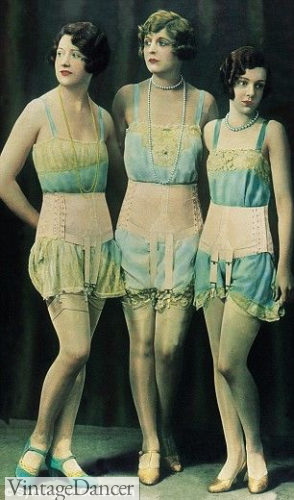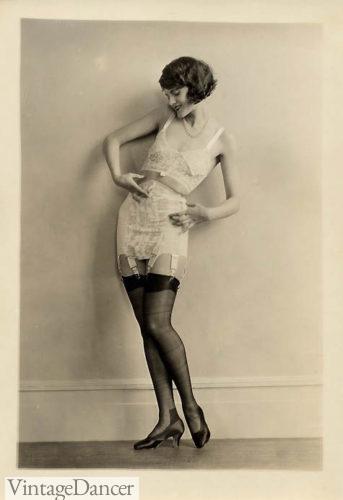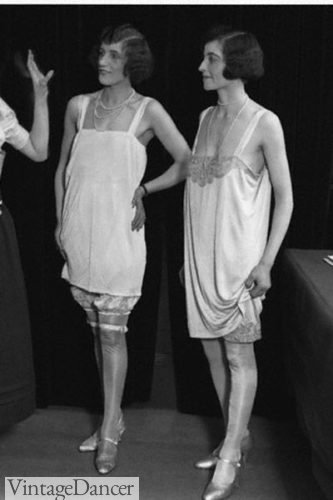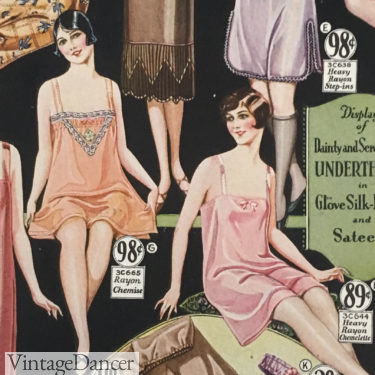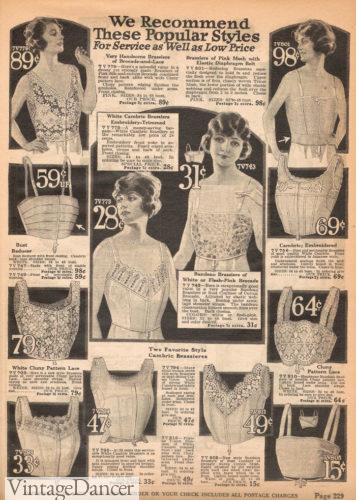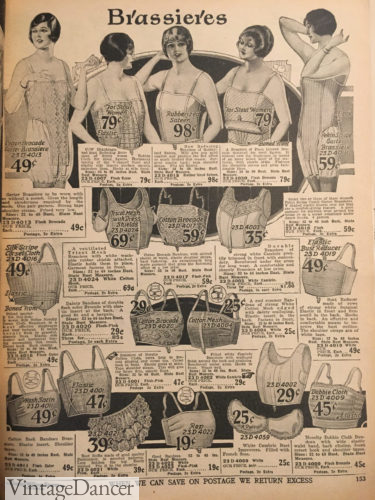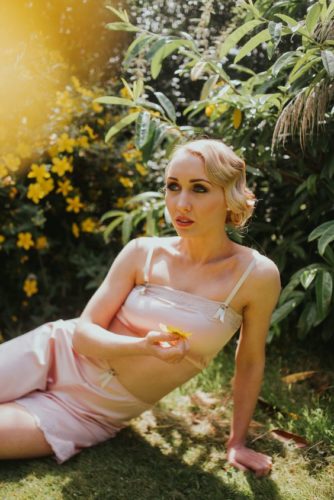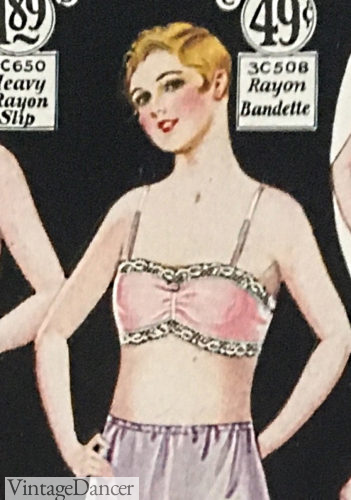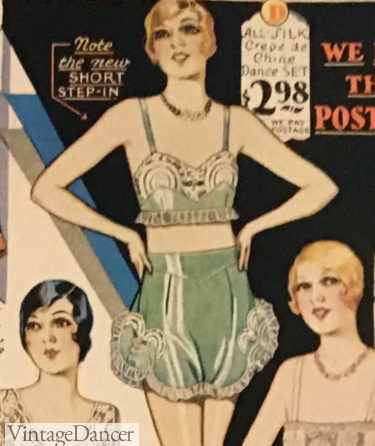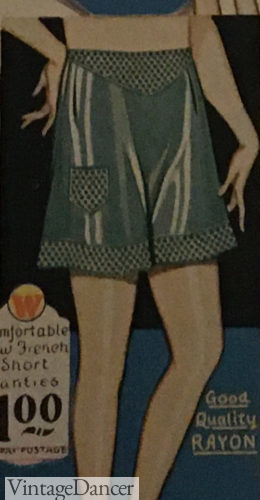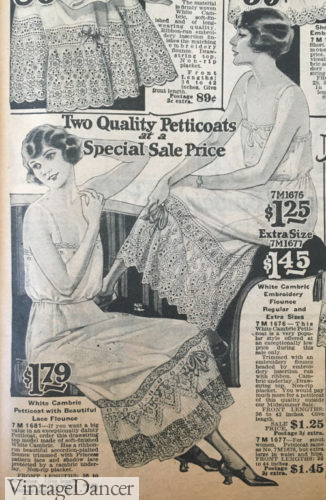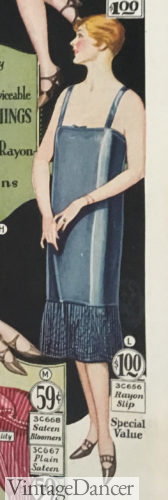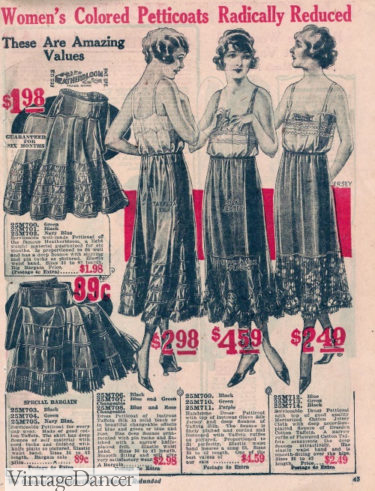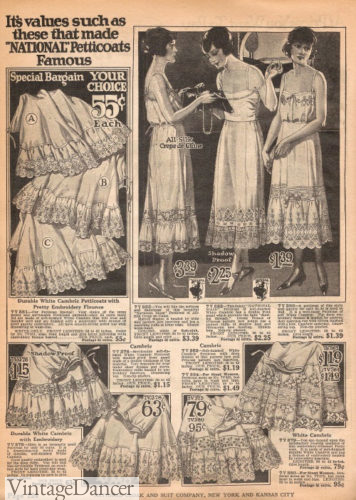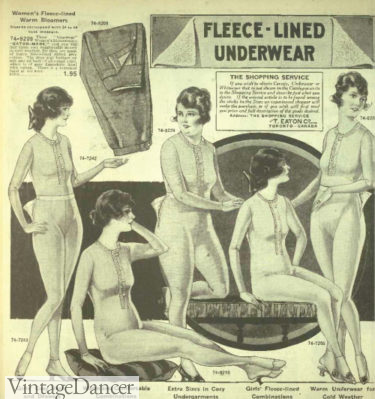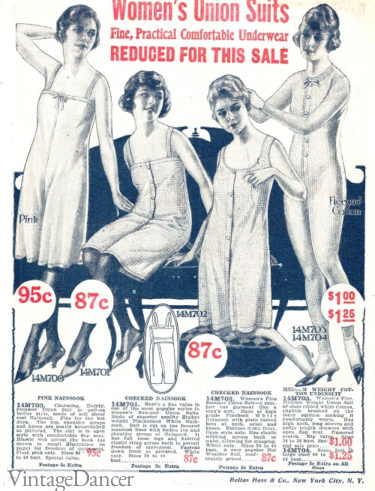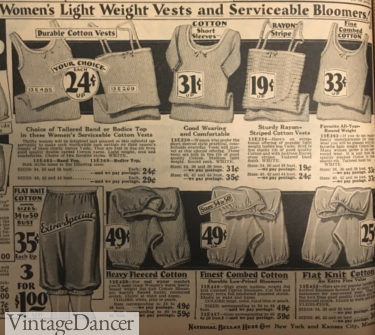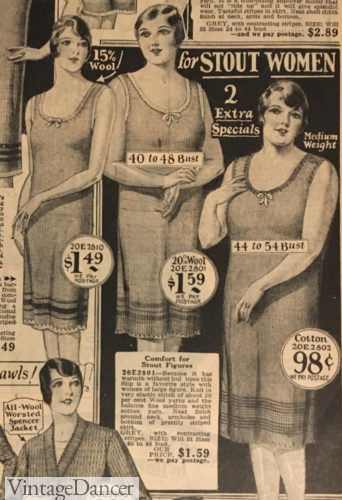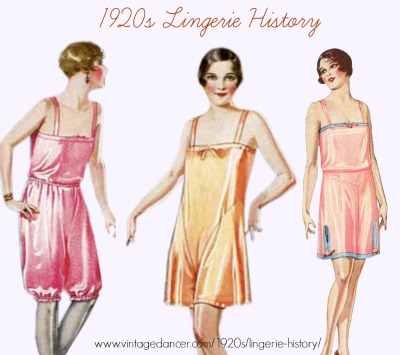
The slim silhouette and lighter style of dresses in the twenties also had a dramatic effect on women’s 1920s lingerie. In the 1900s, a woman would wear drawers/bloomers, a chemise, corset, corset cover, and several petticoats underneath her dress. Up to 11 layers of lingerie were put on a well-to-do lady. By the end of the 1920s, a woman could only wear a brassiere with a teddy and be sufficiently dressed in lingerie. What a dramatic change in only a few years!
Lingerie fabric choices included cotton and silk in the form of satin, pongee, shantung, crepe de chine, and silk glove. Artificial silk, called Rayon after 1924, was a good middle-class choice of fabric. Rayon was easy to dye, so new colors of peach, pink, pastel green, and flesh were available instead of just white. Black was rare, but a good option for dark-colored sheer eveningwear and movies stars in black and white films.
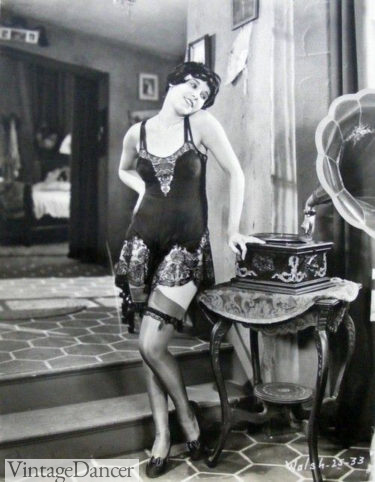
Silent screen actress, Fifi Dorsay, in black cami knickers lingerie holding up black stockings
Rayon breathed well and was considered very sanitary (a concern for all women in the twenties). It could be woven or knit in flat or textured fabrics. In the second half of the decade, printed fabrics were becoming trendy. Dainty decorations such as Chantilly lace, applique, embroidery, pin tucks, picot edging, and ribbon flowers were added to lingerie at the neckline or hem. 1920s underwear was as pretty as the outerwear.
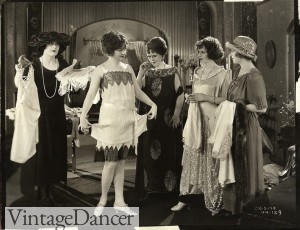
1920s movie still showing off a lovely white slip with black lace and matching bloomers underneath.
The year, season, styles of outer garments, and a woman’s body type determined which lingerie items a woman wore. Thin women could get away with less, while a curvy woman had to create the illusion of a flattened tube with a few layers. Fancy dressing required the most layers, while sportswear or at home house dresses required the least.
Corsets
It is important to understand right off the bat that corsets were still worn into the 1920s and beyond. Older women preferred the traditional lace-up boned corset. Curvy women also wore them more often than thin women. Between 1920 and 1928, corset sales declined by two thirds, but corset makers adapted to changing needs.
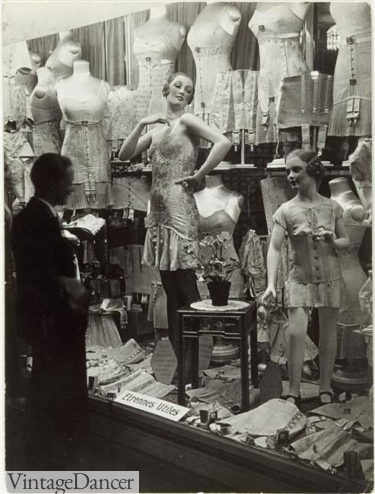
Paris shop window, corsets and lingerie (notice the corsets for girls too)
The ideal corset was not designed to give a woman more curves but to flatten the front and backside. Lacing and elastic panels helped shape the figure and boning kept the torso flat.
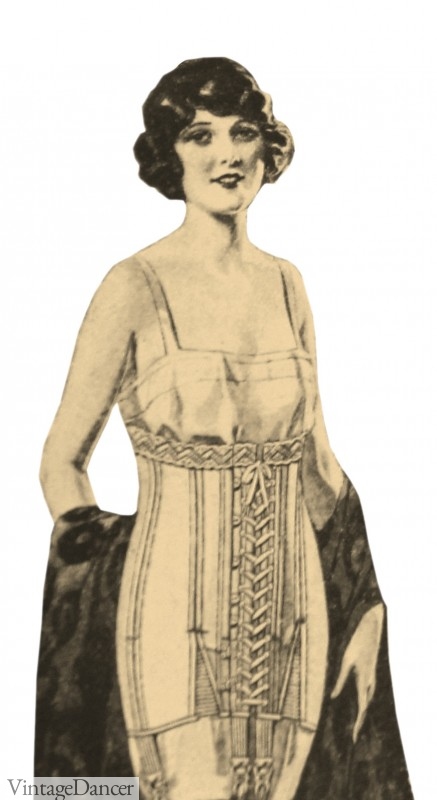
1920s corset with front lacing to “reduce”
A heavy-duty corset had a corset girdle on the inside and a longer corselette on the outside that extended from over the bust down to the thigh. Long corselettes made walking a slow, stiff gliding motion.
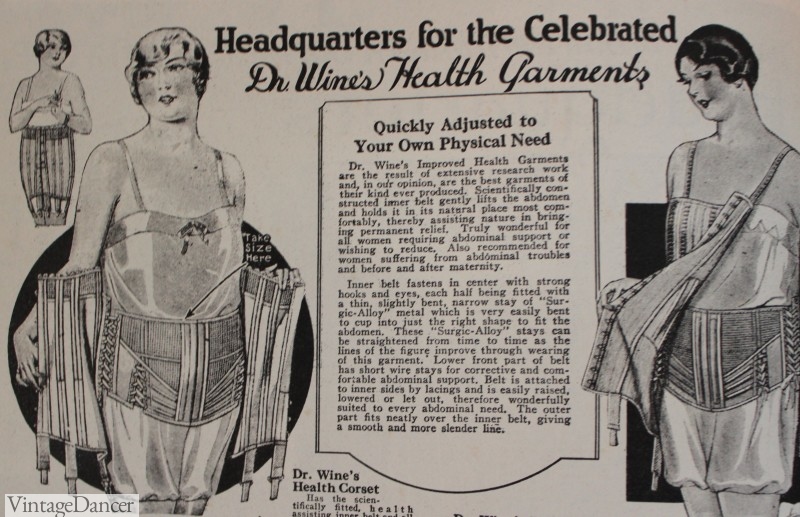
“Good for Health” corset both lifts belly up and in and then smooths and flattens with the outer layer for “reducing” effects.
Were corsets comfortable? For women who grew up wearing corsets in the Victorian age, a well-made corset that fit her body to a T was perfectly comfortable. Many women handmade corsets to ensure the best fit. They provided the same support as a back brace today. Elastic panels increased comfort and provided more flexibility to bend and move.
Young women who had yet to spend their daily life in a corset preferred not to wear them. Fast flappers refused to wear corsets. “The men won’t dance with you if you wear a corset,” cried the young flappers. Many dance establishments included “corset check rooms,” where girls who left home wearing a corset could remove it before the dance. Only unconfined flappers could run, dance, and drive cars in un-restricted comfort. But as bodies changed and expanded and fashion lines dictated, even they turned to corsets to wear on dressy occasions.
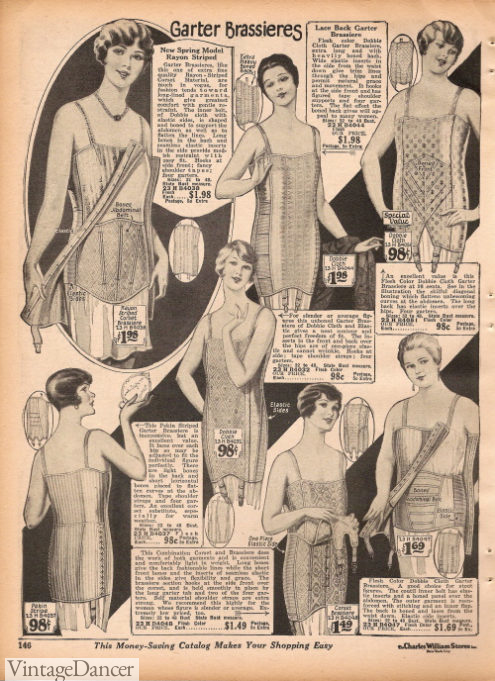
1927 garter brassieres
The sale of the underbust corset declined as younger women chose the lighter corset + brassiere combination called a corselette, corsette, doublette, garter brassiere or girdle corset. The corselette had side fasteners, shoulder straps, and sometimes long elastic panels or light boning, all of which combined to obliterate any curves that might disrupt the 20s silhouette. The effect was not to reduce or tighten as much as it was to create a tube shape with little definition from the bust to the thighs.
Long corselettes produced the boyish figure, but instead of thick boning, many thin women preferred light elastic “Lastix” girdles that flattened the abdomen. They squished tummy flesh flat starting at the natural waist and ending at the top of the hip. These were to become more common in the 1930s as the long and lean look added breasts and curves back into fashion.
- Light waist girdle corsets with garters over a chemise
- Bra and girdle corselet, late 20s
Garter belts too became an option at the end of the decade. Also called abdominal belts they were a blend of fabric belt and elastic side panels with 4-6 garter clips to hold up stockings. See more about stockings here.
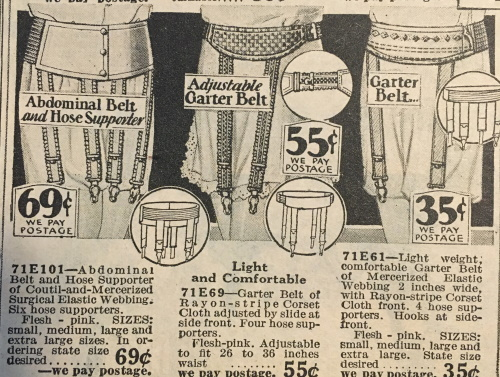
1929 garter belts
Underbust corsets and corselettes were worn over a vest, cami-knickers or step-in chemise. Another slip over the corset kept dresses from rubbing on the corset boning and helped with the correct hang of the dress. 4-6 hose supporters, metal garters, hang from the hem on elastic pieces that attached to stockings. Using the ladies room with all of these layers was never an easy or quick experience.
- 1925 chemise and bloomers
- 1928 chemises (shorter and looser than a long slip) worn under corsets
Bra, Brassiere
In the first few years the old Victorian corset cover became the camisole top. It had a square neckline with straps, a gather top with ribbon and an elastic waist. It could be worn over, under or instead of a bandeau bra. Because it did little to flatten the bust it quickly went out of fashion. By 1929 it was back again, called a vest, without the gathered top and bottom, and worn with pantie knickers.
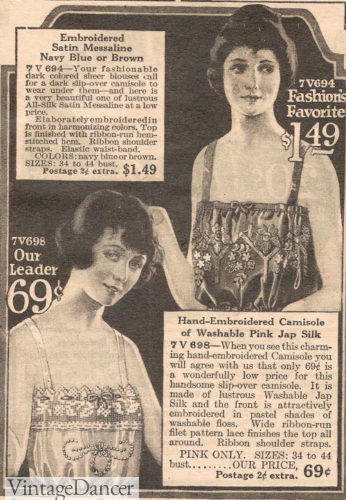
1922 camisole
For women who did not need or want to wear a full corset or corselette, they had the choice of a new invention, the brassiere. It was more often called a bandeau but also a bust confiner or bust bodice. It was a simple rectangle piece of fabric worn tightly across the chest with two 1 inch straps over the shoulders. Lighter ’20s models had gathers in the center to create subtle cups.
A buxom woman’s bandeau brassiere was made of heavier twill cotton or brocade and had longer lengths. Many adopted the Symington Side Lacer, a bra that could be laced at both sides and pulled in to flatten the chest. A linen or silk bandeau/bust bodice/bust confiner that had elastic in the back and fastened on the sides could also function as a 1920s brassiere. Most firm brassieres had garter hooks on the front to attach to a waist corset or girdle.
- 1922 bust confiners
- 1925 bra variations
Available in white or fleshy pink, they were made of lace, silk or rayon for small busts. The prettiest bras had lace trim and small ribbon bows. Embroidery decorated the most expensive lingerie. A small corset tab in the front and center attached to a separate girdle on some models.
- 1920s simple bandeau bra (House of Satin, out of business)
- 1928 rayon and lace bra
Strapping the “girls” down had negative effects on breast shapes. Many women in the thirties and beyond said their breasts never came back to their previous perky life. As the decade came to an end, more women began to wear bras with cups that were designed to lift and separate, courtesy of the Maiden Form Brassiere Company.
Knickers, Bloomers, Panties
What we would simply call underwear or panties today were called knickers or bloomers in the ’20s. The material became lighter and less bulky with crepe de chine being very popular, along with silk and cotton. Knickers typically had an elastic waist and knee caps. Some had a smooth waist yoke in the front and elastic in the back. They came in orange, peach, violet, jade green, blue, yellow and pink colors.
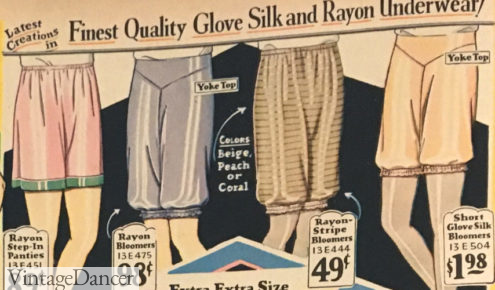
1929 bloomers
Towards the later end of the decade the wide leg shorts with a separate bra were fashionable for young women. Some had amble lace trim for fullness while others were more tailored, looking more and more like men’s underwear. The pointed waist yokes in the front and back were cut on the straight of the fabric, while the side pieces were cut on the bias. They hand a variety of names such as step-in drawers, short panties, and step-in shorts.
- 1929 wide leg shorts
- 1929 tailored shorts
Step-Ins / All-in-ones
The cami-knicker / cami-bloomer, combining the camisole and knickers, were popular with women who liked all-in-one undergarments. Notice how loose they fit? There was a very wide leg pantie called a skirt drawer which acted as a combination bloomer and slip. The chemise step-in, envelope chemise, or teddy had no elastic waist and snap or stitched together crotch. The fullness in the skirt eliminated the need for a separate slip. The more popular elastic bloomer leg cami-bloomer became the most worn underwear of the 1920s.
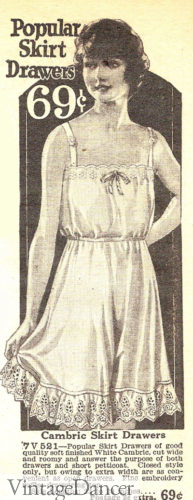
1922 skirt drawers
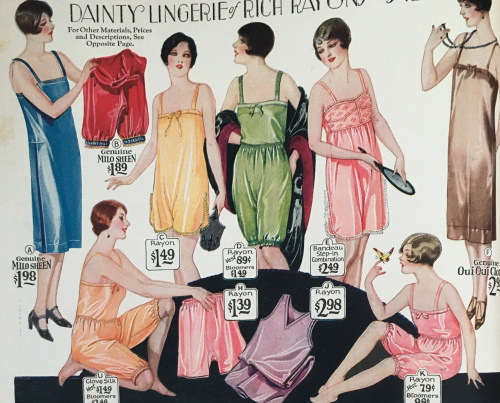
1927 step-ins – chemise, bloomer and knicker styles
Some step-ins had pointed waist yokes that were cut on the straight of fabric while the side pieces were cut on the bias, allowing the fabric to fall in graceful fluted folds. They were about as far away from a corset as you can get, complete with a button or snap crotch and drop seat in the back.
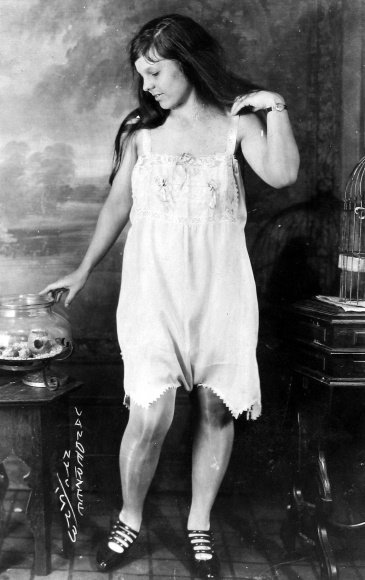
1923 envelope chemise with snap crotch
The step-ins were intended to be worn next to the skin. They could be worn over a bra and corset or on its own for the very flat chested. They are very similar to modern-day romper pajamas like these.
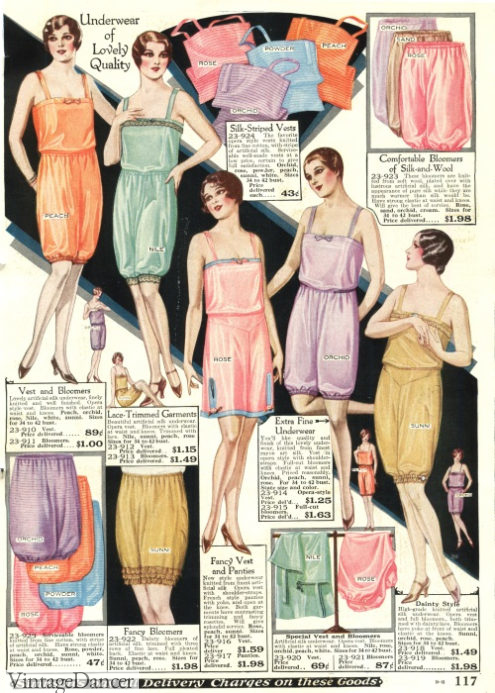
1928 cami-bloomers
Dress Slips
Slips served the same purpose back then as they do now. They were a necessity under light dresses to keep the dress fabric from clinging to the body. Many dresses were sold with matching slips that prevented immodesty when wearing a sheer fabric evening dress. These shadow-proof slips fell straight on the body but may have had additional pleats at the hips for ease of movement. The slippery material was good for keeping the dress from clinging to the body but bad for the straps staying in place. Clips or pins on the inside fasted the slip to the dress.
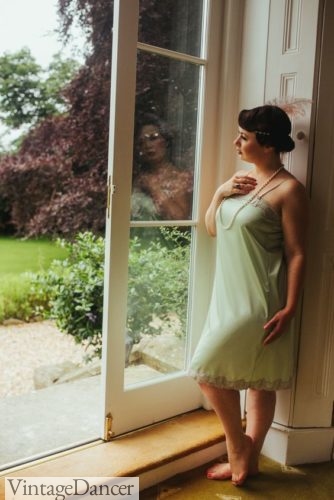
Reproduction 1920s slip
Most slips had low “opera” necklines, meaning square with a pretty ribbon, self-fabric or lace straps. Some had a drawstring waist below the bust while others were linerear tube shaped, whatever the silhouette of the day called for. Lengths varied to fall within a few inches of the dress hem. Some had long pleated hems or short little ruffles but most were plain to trimmed with flat lace.
- 1922 drawstring waist slips
- 1923 shadow-proof slip with side gathers
- 1928 blue slip with pleated hem
- 1928 pink slip with ruffles
Petticoat skirts trimmed in ruffles, tiers and flounces that fell to the calf were worn in the earlier part of the decade, but as hemlines rose, women turned to the slip. The petticoat made a comeback near the end of the decade, as it was fashionable to wear more than one under a full-skirted chiffon dress in the evenings.
- 1921 black, Navy blue, green or purple taffeta or silk petticoats
- 1922 white cotton petticoats
Slips and petticoats were never supposed to show below the dress hemline. If a woman saw a friend with an exposed undergarment, she might say “Hey, it’s snowing down south” and she would quickly run off to fix it. This phrase lasted well into the 1960s, when dresses stopped being worn with slips.
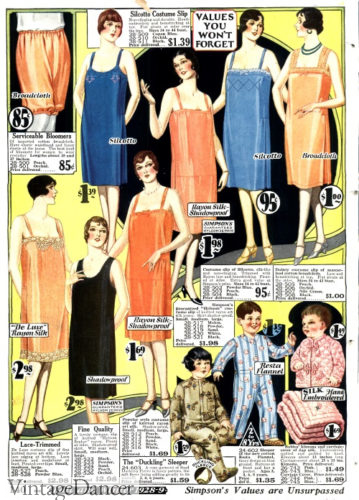
1928 slips for stout/plus size women
Winter Lingerie
For winter, the light rayon chemise or step-in was too cool. Wool, silk or cotton Nainsook union suits (long johns) were worn instead, however, the legs and arms were cut short to accommodate shorter hem and sleeve length dresses. They still had back flaps buttoned or snapped into place, a wrap over back flap, or buttons down the front and inside the crotch.
Step-ins and chemises, slips, bloomers and camisoles called vests were also made of winter weight knits. Vests looked like sleeveless tank tops with thick or thin straps and were long, covering the hips. A short sleeve shirt version was also an option with a wide scoop neck.
Winter lingerie could be layered for maximum warmth or mixed with lighter lingerie for springtime. Most were white but pink and grey were alternative colors. Decoration was minimal- perhaps some lace or ribbon around the neckline.
- 1920 long union suits
- 1921 union suits and step-ins made of Nainsook
- 1929 knit “vests” and bloomers
- 1929 winter knit slips
Lingerie Tips for Today
The proper undergarments will do wonders in creating the ideal ’20s silhouette. If you wish to make your own there are patterns available, mostly for step-ins, brassieres, and chemises.
If you survey women who dress in 1920s attire regularly most do not wear period-correct undergarments, instead choosing modern shapewear. The look is close but never as ideal as genuine vintage or reproduction undergarments. Here are some options I recommend.
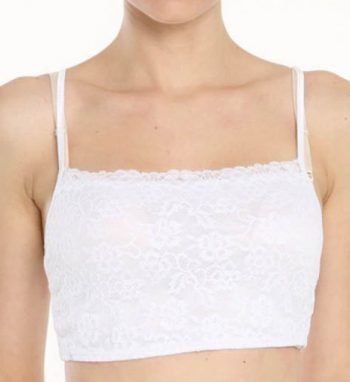
A good bralette for a 1920s flat chest
Bra – A sports bra or strapless non-padded bralette or kimono bra will give you a flattening effect. I hear some women have used elastic first-aid bandages to tape the girls down- just don’t tape them too tight. I prefer a bralette over a sports bra for light support and a delicate feel. Full chested women could use modern minimizer sports bras for a similar effect with support.
Slip – Nearly any modern slip will work for you as long as the cut of it doesn’t show under your dress and is loose, not tight. Most modern slips are V-neck which shows more cleavage than the ’20s square neck. You can make one too, very easily. ALWAYS wear a slip under your dress, skirt or blouse. If your dress clings to your every curve, it is too small — get a bigger size dress.
Corset/ girdle – This is the toughest part to recreate. Costume corsets or mid-century girdles won’t create that long line corselette that worked magic in the ’20s. It also may be next to impossible to find a modern corset that won’t give you an hourglass figure. I sometimes use waist training underbust corsets or girdles but I leave them loose so they won’t create curves. For comfort, wear a thin cotton tank top between your skin and the corset.
Your next best option is to wear a full-body stretchy shaper (one that combines a tank top and shorts/skirt into one). Spanx nylons help, too, at the very least create a “slimming effect” (but may also widen you, as it does me.) One of these combined with a flattening bra and a slip will give you a pretty good ’20s silhouette.
Bloomers/ knickers – You really don’t need these to create the correct shape but they are fun to wear and help against chub rub/thigh rub. I usually wear rib to knee shapewear or a pair of cotton yoga shorts. A thin nighty romper is another option for the all-in-one look.
Garter belt – While garter belts didn’t exist until the very end of the ’20s, they will be needed if you wear thigh high stockings (without rubber grips) and no corset. I suggest wearing the garter belt under your underwear to keep them from slipping down.
What order should I put on lingerie? The answer depends on what lingerie you choose. I suggest: stockings and shoes first, then a chemise all-in-one/slip (or long cotton tank top), bra and or corset, bloomers/panties, and slip. If you don’t wear a corset you don’t need to start with a chemise/slip/tank top layer. A bra + panties + shapewear + slip will work well enough for most figures.
1920s Style Lingerie
Shop 1920s style lingerie: New lingerie with the silhouette of the 1920s, reproduction 1920s lingerie, and sewing patterns to create your own.
Debbie Sessions has been teaching fashion history and helping people dress for vintage themed events since 2009. She has turned a hobby into VintageDancer.com with hundreds of well researched articles and hand picked links to vintage inspired clothing online. She aims to make dressing accurately (or not) an affordable option for all. Oh, and she dances too.
